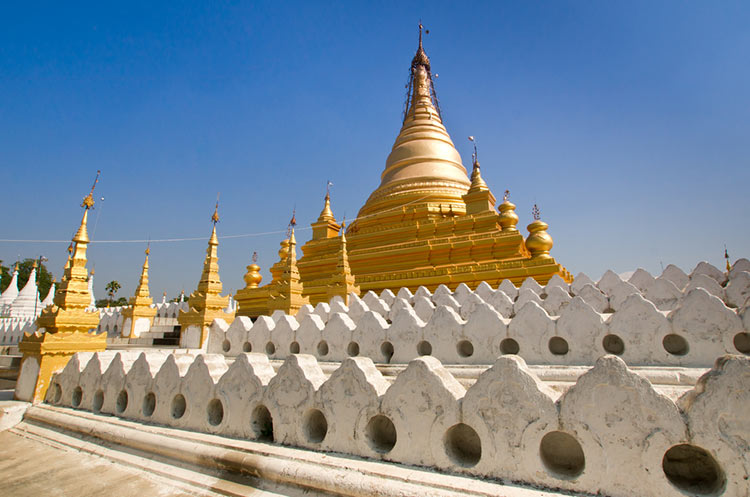
Sandamuni Pagoda
Largest iron Buddha image & 1774 slabs inscribed with Buddhist teachings
The Sandamuni pagoda in Mandalay is known for its large golden zedi, its hundreds of shrines containing inscribed marble slabs and the largest iron Buddha image in Burma, the Sandamani, after which it is named.
At the foot of Mandalay Hill
Resembling the nearby Kuthodaw pagoda, the Sandamuni is located at the foot of Mandalay Hill with good views of the hill and its monasteries.
The pagoda was built as a memorial to crown Prince Kanaung, who was murdered in 1866 by two of King Mindon Min’s sons, who were unhappy not to be the first in line to become the next King. The bodies of the crown Prince and three of his sons who were also killed were entombed on the Sandamuni pagoda grounds. In the early 1990’s the tombs were moved to a mausoleum in Mandalay.
Golden pagoda
The oldest structure on the grounds is the golden chedi. The chedi was built in 1874 by King Mindon Min on the site of his temporary Palace while the nearby Royal Palace was being built. Covered walkways through hundreds of shrines lead towards the zedi in the center of the complex. Set on a base of three square tiers of diminishing size, the conical stupa is topped with a multi tiered hti, an ornamental spire.
1774 Shrines housing inscribed marble slabs
Surrounding the central pagoda are 1774 shrines, each housing a single marble slab. The slabs are inscribed with the teachings of the Buddha, consisting of Sutta Pitaka, Vinaya Pitaka and Abhidhamma Pitaka (the three baskets that make up the Tripitaka), as well as commentaries and sub commentaries.
Each slab measuring 1.68 meters tall and 1.07 meters wide is enshrined in a small white shrine named Dhamma ceti, Dhamma being the teachings of the Buddha and ceti the Burmese word for chedi or stupa. The white shrines are topped with a hti, an ornamental spire shaped like an umbrella. The grounds are more cramped than the nearby Kuthodaw pagoda; little space is left behind the rows of Dhamma cetis.
The Dhamma cetis were built several decades after the central zedi. They were erected in 1913 by U Khanti the hermit, who is known in Burma for having renovated a great number of Burmese temples and pagodas.
Sandamani Buddha image
The Sandamuni pagoda houses the largest iron Buddha image in Burma, named the Sandamani image. The image was cast in 1802 by Bodawpaya, King of the Konbaung dynasty of Burma. Made of almost 41,000 pounds of iron, it is now covered with a layer of gold. The image was moved to Mandalay from the old capital Amarapura, a few kilometers South West of Mandalay. The image in the Bhumisparsha mudra of “Calling the earth to witness” is enshrined in a worship hall.
Also brought over from the Palace in Amarapura were 18 statues of Arhats representing the 18 Arhats, the first followers of the Buddha, who lived with the Buddha some 2,500 years ago. They are now enshrined in smaller stupas around the main pagoda.
How to get to the Sandamuni Pagoda
The pagoda is located on the foot of Mandalay Hill in the North of Mandalay, just Northeast of the Royal Palace and a short walk from the Kuthodaw pagoda.
Opening hours
The Sandamuni pagoda opens daily from 8 am until 8 pm.
Entrance fee
Entrance fee is US$ 5 per person.